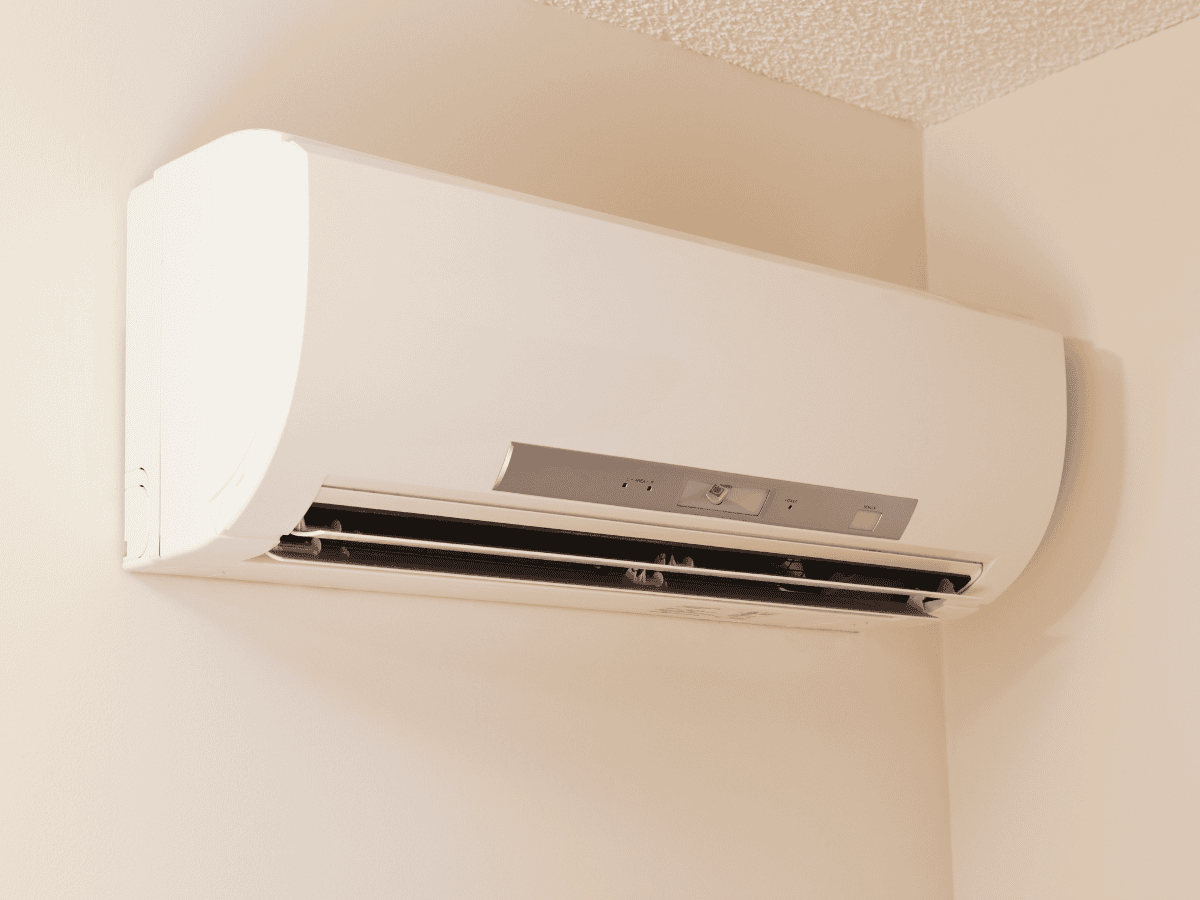Are you tired of uneven temperatures in your home, skyrocketing electric bills, or the hassle of installing ductwork during a renovation? A mini split system could be the cooling solution you’ve been searching for.
But before deciding, it’s essential to understand both the advantages and drawbacks. Mini split systems offer flexible, energy-efficient heating and cooling, but aren’t ideal for every situation.
In this guide, we’ll break down the key pros and cons of mini split systems to help you make the best choice for your comfort and budget.
What Is a Mini-Split System & How Does It Work?
A mini split system is a modern AC system that provides heating and cooling without traditional ductwork. It consists of two primary components:
- Outdoor Unit – Contains the compressor and condenser.
- Indoor Unit(s) – Mounted on walls, ceilings, or floors, these units distribute conditioned air directly into individual rooms.
A small conduit connects the indoor and outdoor units through the wall, carrying refrigerant, power, and drainage. Because they deliver air directly where it’s needed, mini splits are ideal for:
- Homes without existing ductwork.
- Room additions and renovations.
- Garages, sunrooms, living rooms, basements, or bonus rooms.
Now it’s time to take a closer look at the pros and cons.
Advantages of Mini Split Systems
1. Energy Efficiency
These systems can significantly reduce energy consumption by avoiding the energy loss associated with ductwork and offering precise temperature control. Many models are Energy Star rated and include inverter technology to modulate compressor speed.
Since mini splits deliver conditioned air directly to rooms, there’s less waste compared to central systems. The efficiency often translates into lower monthly energy bills and long-term cost savings.
2. Easy Installation
Mini splits don’t require ductwork, which means installation is often quicker and less invasive. This is great for older homes, room additions, or spaces without existing ducts. Because fewer structural changes are needed, it minimizes disruption to your home and allows for faster project completion. Homeowners appreciate that professional AC installation for mini split systems often takes only a few hours, depending on the layout.
3. Zoned Comfort
One of the standout benefits is the ability to independently control temperatures in different areas of your home. You can cool only the rooms you’re using, which saves energy and money. Each family member can set their own comfort level in their personal space.
This also prevents the common problem of over-conditioning unused rooms, making multi-zone configurations highly desirable—especially when comparing mini split AC systems to traditional central air in terms of flexibility.
4. Improved Indoor Air Quality
Mini splits often come with advanced filtration systems that can help reduce dust, allergens, and other pollutants, offering cleaner air compared to some traditional HVAC systems. Without ductwork to harbor dust and mold, air stays cleaner and healthier. This makes mini splits a great option for allergy sufferers or homes with pets. Routine cleaning or replacement of air filters is key to maintaining this benefit.
5. Quiet Operation
Both the outdoor and indoor units operate at lower noise levels, often quieter than a refrigerator. This makes them ideal for bedrooms, home offices, or nurseries. Unlike older HVAC systems that cycle loudly, mini splits run smoothly and quietly. You’ll barely notice when the system is on, which adds to overall comfort.
6. Flexible Design Options
Indoor units come in several styles, including wall-mounted, floor-standing, and ceiling-recessed options. They can blend with different interior designs without requiring major renovations. The compact size of mini splits allows for more creative room layouts, whether you’re designing for a small guest room or a whole house setup.
7. Ideal for Additions & Renovations
If you’re building an extension or renovating a space, mini splits provide an efficient and non-disruptive solution to keep new areas comfortable without extending existing ductwork. They eliminate the need to overhaul your existing HVAC infrastructure, making them ideal for garages, attics, sunrooms, and finished basements.
8. Smart Controls
Many mini splits include remote control, scheduling, and smart home integration. Wi-Fi-enabled systems let you adjust settings from your smartphone, even when you’re not home. This convenience means you can manage your home’s climate from anywhere. Some systems even learn your habits and optimize performance automatically.
9. Lower Operating Costs Over Time
Though the upfront investment is higher, many homeowners notice significantly lower energy bills each month. These systems require less energy to run, which means more savings over their lifetime.
If you’re debating whether to replace your existing unit, understanding how long HVAC systems typically last and the importance of regular inspections can help guide your decision.
10. Environmentally Friendly
Mini splits use eco-friendly refrigerants and are designed with energy conservation in mind. Reduced electricity usage helps minimize your carbon footprint. Choosing a mini split system supports sustainability without sacrificing comfort.
Disadvantages of Mini Split Systems
While mini split systems offer many benefits, they also have some trade-offs. Understanding the various drawbacks can help you decide whether they align with your home’s layout, budget, and long-term comfort goals.
1. Higher Initial Cost
Initial purchase and mini split installation costs can be more expensive than conventional HVAC systems, particularly if you need several indoor units to cover multiple rooms. However, these costs may be offset by energy savings over time. Budgeting for these systems may require more planning, especially for larger homes. Still, the long-term operational savings often help balance out the investment.
2. Aesthetic Considerations
Some homeowners dislike the look of indoor units mounted on walls or ceilings. Unlike central air, which is mostly hidden, mini splits are more visible within your living spaces. This might not suit those who prefer a more streamlined or minimalist home decor. Though some models offer sleeker designs, they are still not completely invisible.
3. Regular Maintenance
Filters in indoor units need regular cleaning or replacement to maintain air quality and efficiency. Neglecting maintenance can lead to reduced performance and potential repair costs. Keeping up with maintenance is essential to avoiding unnecessary wear and tear. Scheduling routine checks ensures your system remains reliable year-round.
4. Installation Requires Professional Expertise
DIY installation is not recommended. For the best performance and to keep the warranty valid, it’s important to have the system professionally installed by a qualified technician. Incorrect installation can reduce efficiency and lead to long-term issues. Hiring a trained HVAC technician ensures safety and proper configuration.
5. Limited Heating Capacity in Extreme Cold
Some models may struggle to maintain comfort in very cold or very hot climates without supplemental systems. It’s important to choose a unit rated for your local weather conditions. In harsh winters, additional heating solutions might still be necessary. Always check the specifications to ensure the system suits your region’s extremes.
6. Space Requirements
Both the indoor and outdoor units require dedicated space. In compact homes, finding suitable wall and exterior locations may be challenging. The outdoor unit also needs proper clearance for airflow and maintenance. This can be a consideration for homes with small yards or limited exterior access.
7. Electrical Requirements
Mini split systems often require a dedicated electrical line, which might necessitate upgrades to your existing panel. This can add extra costs and time to your installation process. Working with a licensed electrician ensures your system is safe and compliant with local codes.
8. Limited Air Circulation
Mini splits direct air to the area where they’re installed, but may not circulate air as evenly as ducted systems throughout the home. This could leave some spots cooler or warmer than others unless multiple units are installed. Strategic placement and multiple zones help minimize this issue.
9. May Not Increase Home Value Equally
While they offer many benefits, some buyers may prefer traditional systems when evaluating resale. Depending on your market, this could affect perceived property value. It’s a good idea to consult a real estate expert if you plan to sell soon.
10. Learning Curve for New Users
Mini split systems come with remotes and smart controls that may be unfamiliar to some users. Navigating settings like modes, fan speeds, and timers can be confusing at first. Taking the time to learn your system ensures you get the most comfort and efficiency out of it.
Is a Mini Split System Right for You?
Mini split systems offer impressive benefits, especially when it comes to efficiency and comfort. But they aren’t perfect for everyone. If visual appearance, upfront cost, or climate-specific performance is a major concern, it’s worth weighing these considerations before upgrading your HVAC system to ensure a mini split aligns with your needs.
At River Valley Air Conditioning, we’re here to help you understand the ins and outs of these systems so you can choose the right solution for your home. Our knowledgeable and approachable team is here to answer your questions and support you throughout the entire process.
Final Thoughts
Many homeowners choose mini split systems to improve indoor comfort and efficiency. However, understanding the disadvantages of these systems is just as important as appreciating their advantages.
If you’re curious whether a ductless mini split is the right cooling system for your home, call us anytime for a free consultation. We’ll help you make a confident, informed decision—with no pressure, just honest advice.
Ready to take the next step? Contact River Valley Air Conditioning today and let’s get started on making your home more comfortable, one room at a time.

